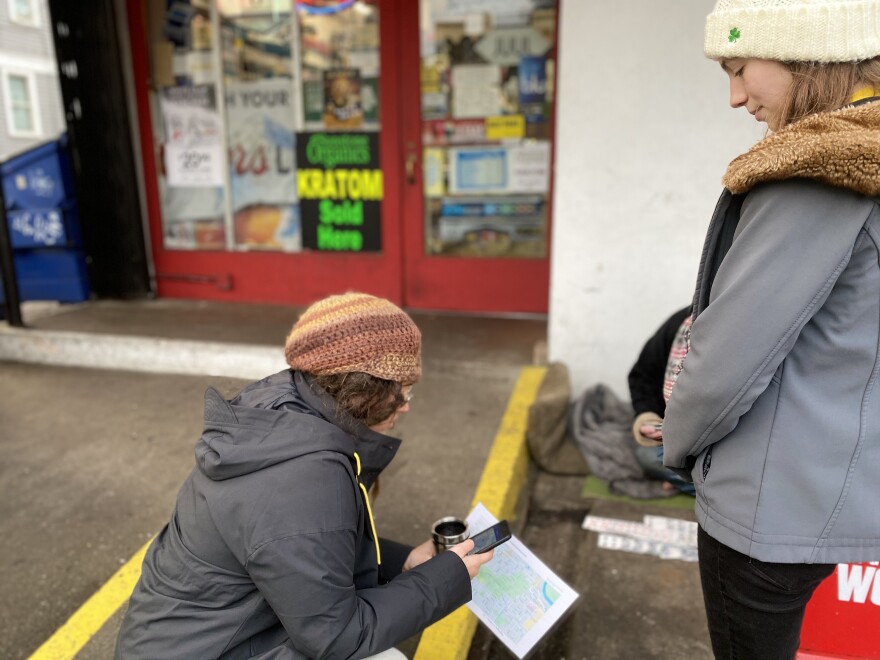Across the nation last week, counties participated in an annual tally of people who are unhoused. KLCC’s Elizabeth Gabriel tagged along with a pair of volunteers in Eugene to see what it’s like to be a point-in-time counter.
Training
In the weeks leading up to the count, employees of Lane County Health and Human Services held volunteer trainings.
Lora Ashworth is an Administrative Analyst for Lane County Human Services. During a training a week before the count, she provided tips for approaching people in order to be respectful and keep everyone safe.
“People definitely live in all types of situations,” said Ashworth. “It's tough to find a place where you can hunker down and feel safe, and feel like you're not gonna get your things taken or get moved along or arrested.”

Ashworth said every time she does street outreach, she talks really loudly as she walks by so she doesn’t startle anyone in a tent.
“This is more of a respect thing—just letting somebody know that you're coming in,” said Ashworth. “So I'll talk to my partner about Disneyland or the sky—doesn't really matter. But just letting people know that you're coming.”
She said if counters are engaging people where they live, they should be careful of what is on the ground so they don’t damage someone’s belongings.
“You want to be looking on the ground because they don't have the same access to trashcans that you do in your home or things like that—so I'll be looking for broken glass,” said Ashworth. “I will tell you as an outreach worker—where there is paper, somebody has probably gone to the bathroom. So just, you know, pay attention to that.”
She also recommended that people have safe words in case they end up in a situation that doesn’t feel safe.
“I used to say red folder,” recalled Ashworth. “So I would tell my colleague, ‘Remember to grab that red folder when we get back.’ And then we just calmly left.”
Above all, she encouraged volunteers to be respectful.
“Always treat people with respect,” said Ashworth. “Remember, these are people's homes. They may not be houses, but they are people's homes.”
The Morning of the Count
For the past 17 years, Lane County has tallied sheltered and unsheltered people experiencing homelessness during a 24 hour period. The data is used to determine how much federal funding the county will receive for homeless services.

The Community Alliance of Lane County (CALC) has been Eugene’s deployment center for the past 10 years.
I tagged along with Natalie Dybens and Eleanor Rochester. They got a map and instructions from Lane County Health and Human Services employee Alexandria Dreher.
Counters put an app on their phones in order to submit their surveys. According to Health and Human Services employee Melissa Coloma, by enabling their phone’s location setting while using the app, analysts will be able to pinpoint where counters were when they did each survey.
Interacting with the Unhoused
We parked in the Whole Foods parking lot and started walking from there. It took about 20 minutes before we found people on the street.
The second person they approached was someone laying underneath a blue tarp.

Asked Rochester, “Excuse me. Anybody in there? I'm sorry to wake you. We'll move on if you don't want to talk to us. We're volunteers with the point in time count.”
Dybens and Rochester approached many people who described themselves as houseless. Some with tattered clothes and no shoes, whose hands shook as they spoke. A few with canine companions, and some who were clean-shaven.
Given the rules of the volunteer training, the personal information of countees is supposed to remain confidential. So, I turned my recorder off when the volunteers asked people questions.
Dybens and Rochester surveyed at least 30 people. Dybens said there were about five times as many unwilling to take the survey as those who were willing. Some said they were too busy, while others—like this woman—said they didn’t see a point.
“I don't want to help the government get more money for us being homeless and f*** us over more,” said an unhoused woman. “That’s faulty as f***.”
Sharing their Experience
As our shift ended, Eleanor Rochester shared her interactions with the unhoused population in her work with the HIV Alliance.
“I have never actually been in a situation where I had to extract myself cause I felt unsafe,” said Rochester. “I've just been in situations where people wouldn't stop talking and were trying to like emotionally hook you in.”

Despite having three hours to count, Rochester said it was tough making sure they found everyone.
“I thought we'd be given a smaller geographic area so that we could cover it more thoroughly,” said Rochester. “I kind of expected to be able to go across the whole area, like in the amount of time we were given.”
Natalie Dybens has participated in the point-in-time count two other times in Santa Cruz, California. She said there were more clusters of people here, but she was surprised by people’s friendliness.
“I was still expecting that maybe we'd get some more grumpy people,” said Dybens. “I mean—there was some grumpiness—but not so much at all. I think I got the biggest negative response just from someone who was housed and was offended that I was asking. But you gotta ask. You can't assume.”
We returned to Rochester’s car around 9:50am. We headed back to CALC, where they turned in their badges and map, and confirm that the surveys were submitted through the app.
The data from Lane County’s point-in-time count will be available online in April or May, after their analysis has been received from the Department of Housing and Urban Development.







